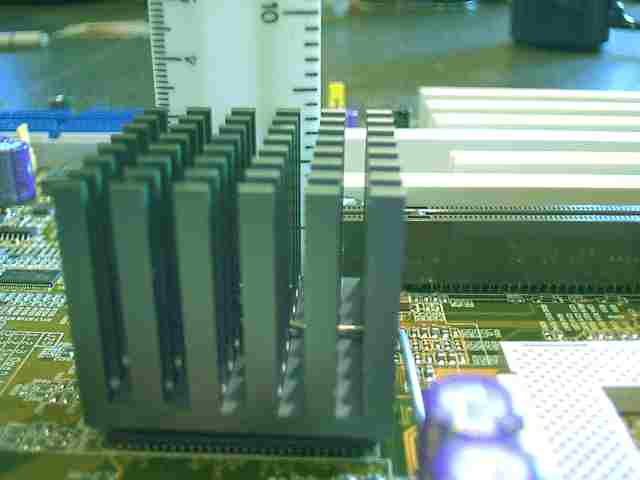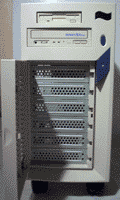|
MPX2
Installation & Practicalities:
Keeping
the neighbours happy:
Some
pairs of CPU's
in Dual-AMD
motherboards can draw up to 150Watts total - a
heat-load equivalent to two domestic lightbulbs within 100mm of each
other.
This vast amount of
concentrated heat-energy needs to be dissipated swiftly from the the
CPU's, the motherboard, then the system-enclosure - ideally without deafening the user.
The
CPU's at the same time need to be supplied with adequate & stable
power, requiring short trace-lengths between the PSU sockets, large
numbers of quite bulky power components, & the socket 462's:
Large
fansinks, short trace-lengths, & masses of capacitors, coils &
other power components are hot-tempered neighbours: keeping the peace between them is a
real challenge for the designers of a dual-AMD motherboard:
Cooling
& layout 1 - CPU's:

Socket#0
- primary, adjacent the DDR slots - has limited room along the lug-axis
due to the presence of yet another of the comforting number of large
capacitors on the MPX2. A Millennium Copper Glaciator [68mm long] just
barely fits - an 80mm long Alpha 8045 won't.

The
Alpha 8045 will not fit Socket#1
[secondary] either - we tried. Note the
large-size mount-holes - perfect for waterblocks - & the absence of
small fragile surface-mounted components adjacent the lugs - the place the
screwdriver always slips onto when pressing the firm clips of modern
fansinks.
| 'Workstation'
cooling - 2 x Silver Mountain's, 60>80mm adaptors, YS-Tech 1.92W
low-noise 2400 rpm fans, Arctic Silver |
 |
 |
| 'server'
cooling - 2 x Kanie Hedgehog's, 60>80mm low-profile adapters,
Nidec BetaV variable-speed fans, Circuitworks 7100 silver thermal
grease |
 |
MPX2
CPU-cooling: conclusions:
After
testing around a dozen fansink models, the CPU-cooling arrangements we
ended up with on the 'workstation' & 'server' systems are very
similar: 'extracting' fansinks such as the Alpha 6035, Kanie Hedgehog, or
Akasa Silver Mountain fitted with low-noise 80mm fans.
It is
our opinion that 'extracting' fansinks best suit the very high
heat-loads on the MPX2 & similar dual-AMD motherboards - they extract
hot air up from the
plane of the motherboard, rather than blowing waste heat down onto it.
Use
of this kind of air-cooling on the MPX2 met our
objective of allowing quite serious overclocking with equivalent or lower noise-levels
to a multiprocessor PIII system fitted with standard Intel retail fansinks.
If
very high
performance air-cooling is required, the Millennium Copper Glaciator fits
OK; but even its 5700 rpm fan - as opposed to the vile 7000 rpm screamers
on cruder products - produces noise-levels we find unpleasant: Millennium
produce quieter models we have yet to test.
Cooling
& layout 2 - CPU monitoring:
The MPX2's
'Iwill Processor
Shelter'
feature is an unattended shutdown, set at a danger-level temperature
selected by the user - at 95C, say, to shut the whole shooting-match off
if a CPU-cooling fan died.
This level is set from the
'PCHealth'
screen in the BIOS, which displays 'core' temperatures of both CPU's; these readings are derived from its onboard Winbond
83627HF & are used to trigger
IPS
Curious as to
the accuracy of all this, we spent scores of hours testing the MPX2's
CPU-monitoring, using
laboratory-quality thermal monitoring equipment:
First, we plotted indicated 'core' temps against rising FSB's -
with the CPU's vcores,
multiplier, & so on being kept the same:

. .
. then, in the next, rather more detailed graph; real & very accurately
measured temperatures from the top & base of the case of each CPU are plotted
against indicated 'core' temperatures as FSB rises - all readings here are
relative to corrected ambient temperatures:

What's
pretty obvious from both graphs is that 'core' temperatures for CPU#1
['PCHealth#1' - top-most red lines]
wander up & down randomly over a 2-3C range, while the FSB steadily rises.
'core'
readouts for CPU#0 ['PCHealth#0']
at least vary in a fairly consistent way
while FSB increases, over 9C &
15C ranges; but while our 'server' system shows a vaguely believable - if
exaggerated - upward slope; our 'workstation' system shows the bizarre behaviour of
indicated 'core' temperatures consistently falling as FSB rises . .
.
| In the
second graph you can see [the bottom 4 slopes] how actual CPU casetop
& caseback temperatures show neatly matched rising trends against the
rising FSB: they also shows clearly how CPU#0's fansink enjoys vastly better
ventilation than CPU#1 - which is shielded from much of the airflow by the
the AGP-card - & how the motherboard's heatsoak effect gives a steep heat-gradient adjacent CPU#0. |
| Raw data from a
test-series may be downloaded in Excel workbook form |
| For the above
CPU-case temperature monitoring, we used Omega copper/constantan
type 'T' thermocouple wire & a Haven Thermocal thermocouple
calibrator, & other instruments calibrated with the Thermocal: measurements are accurate over range to within 0.2C. |
Monitoring
software:
The
'Windows' monitoring software supplied on the installation CD with our MPX2's
-
Winbond 'Hardware Doctor' version 3.3 - does not provide a readout of the
'core' temperature from either CPU - inaccurate as they may be: it is, frankly, a waste of time
installing it: there are superior alternatives . . .
.
. . such as the
famous 'MotherBoardMonitor' freeware utility,
which can provide a 'core' readout only from
CPU#0 [primary] at present - the author of this utility, Alex Van Kaam, is working on enabling both CPU's 'core' readouts from the MPX2's Winbond 83627HF
monitoring IC if & when Iwill sort out the MPX2's BIOS - this IC is also used by other of the
MPX-chipset
motherboards.
To
enable this readout in MBM 5.1.x, select 'LM83-7 [remote 1]' as the sensor
for CPU#0. Other possible sensors provide irrelevant readouts.
|
'core'
temperatures - a reality-check:
The
1.2MHz MP CPU is rated by AMD to withstand a CPU-case temperature of 95C. This
case-temperature is generally between 5-15C lower than the 'core'
temperature reported by the Palomino's on-chip diode.
We
found our overclocked CPU's at '1800+' & '2000+' FSB's &
higher-than-default vcores never ran hotter case-temperatures than 27C
over ambient [the air-temperature inside the PC-enclosure] under any &
every test-load - we could monitor these CPU-case & PC-enclosure
temperatures with great accuracy.
|
MPX2
CPU-monitoring - conclusions:
The
MPX2's monitoring of both CPU's temperatures - vital for the administrator of a MPX2-based 'server' -
is unacceptably inaccurate & inadequate: the MPX2's 'Iwill
Processor Shelter' feature - dependant on accurate 'core' temperatures -
cannot be relied upon.
We
have reported these above flaws to Iwill, & hope that an improved BIOS
may correct them; so that a competent in-OS monitoring utility
such as MotherBoardMonitor will then be able to supply users of the MPX2
with this necessary information.
Cooling
& layout 3: chipset & power components:
Northbridge:
A dramatic feature of the MPX2 is the huge green-anodised
heatsink on the AMD762 Northbridge, clamped down by a cranked spring.

We
removed these, to find: a) the bases of all 3 samples were approx 0.75mm concave,
& b) they were stuck down with double-sided TIM tape. After cleaning
this off with acetone, & lapping the bases flat with coarse al/ox,
then fine silicon-carbide paper sat on a piece of float-glass, we reseated them onto
silver heatsink grease.
Power
components:
For stability, the MPX2
reduces high-load trace-lengths by grouping its 3-phase arrangement of
Mosfets & coils between the CPU-sockets & beside the EPS12V/ATX
2.03 PSU-sockets. An 'L'-shaped passive heatsink is stuck onto the Mosfets
with TIM-tape, with a plastic shield between it & the coils.

Southbridge:
The MPX2 has the 'B2-step' AMD 768 Southbridge - which
gives working onboard USB v 1.1

The
MPX2 has 2 x diagonal mount-holes [not shown] for an active or
passive heatsink over this Southbridge; but please note that this must have the large
65mm
spacing between mount-hole centres, rather than the commoner 60mm spacing -
measure before you buy - any
active cooler must be very low-profile if a full-length card is to be
installed into 64-bit PCI-slot #3.
Power
Supply:
The MPX2's PSU-sockets allow use of either 20-pin+4-pin ATX 2.03
plugs, or [recommended by Iwill] 24-pin+8-pin EPS12V
Please
note that there is at least one alternative 24-pin+8-pin PSU-plug
layout: the proprietary 'WTX' PSU's for the Tyan Thunder 2462 - these will
mechanically fit
the MPX2;
but won't function electrically: if you get one of these by mistake, 2462 'AMD'>EPS12V adapters are
available from stockists or distributors of Enhance PSU's, such as lapicon
in the UK.
Iwill
put yellow warning stickers on the sockets over where the extra pins of
the EPS12V would go. Please note that the smaller ATX plugs [installed
correctly as below] do not engage
& latch firmly onto these dual-standard sockets.

We
tried three different makes of PSU: the Enermax 431 ATX 2.03; the
Enhance
0246 EPS12V, & a cheapo '550W' - in reality 365W RMS - ATX 2.03
PSU from EbuyerUK
Sadly,
we had a bunch of hassles with our Enhance 0246, so cannot test any
advantage this EPS12V design may have under heavy loads: both models of ATX 2.03
PSU's used have been quiet & produced adequate quantities of stable power
on both rails for our CPU's & peripherals.
If
you're using an ATX 2.03 supply, a PSU with at least 200W combined output
from the +3.3v/+5v rails is recommended.
MPX2
component-cooling & layout - conclusions:
It's
clear that Iwill have put in the design-hours with their MPX2, benefiting
from other manufacturer's mistakes, & going through several revisions
before releasing this rev 1.3 product to the public: their care &
attention to detail shows - & in our opinion, pays off in stability
under overclocking stress.
The
AMD762/768 combo needs all the cooling it can get - especially the
Northbridge - & Iwill's arrangements are the best yet of any MPX-chipset
motherboard.
The
MPX2 will disappoint followers of the current fashion for very large [80mm
sq] fansinks;
but it has adequate room for the best alternative:- efficient medium-volume
'extracting' fansinks, fitted with 60>80mm fan-adapters; Iwill should also
be applauded for clearing away the weeny fragile surface components from
the areas round the socket462's lugs.
Watercooling
fans will be happy with the MPX2's large-size mount-holes.
We
also feel the ATX/EPS PSU socket is an ingenious idea, well executed: our
only concern is that ATX plugs don't latch into the sockets positively.
Cases:
The
MPX2's ATX-E-format's great depth, combined with the height of the large
capacitors adjacent the DDR slots - & the height of registered DDR if
installed - makes finding a suitable PC-enclosure tricky.
We
tried around ten cases; & only one NOT a full-height tower - the Codegen
9001 Midi Server case with strongly offset 5.25" devices- physically accommodated the
MPX; even then, its motherboard tray did not reach the fourth row of
standoffs on the MPX2.
A common problem for other cases is the drive-bays for the HD's or lowermost 5.25"
devices getting in the way of the memory or capacitors, or a sufficiently
large cooler for CPU#0.
The
relatively large Globalwin
YCC-802 midi-case used for the 'server' system had to have
its lowermost
CD-device removed, & its motherboard tray did not have pre-drilled
mount-holes for the ATX-E's fourth row of standoffs.
Take
care when sourcing a suitable case for this very large motherboard: it's
unlikely you'll be able to re-use any existing 'midi' tower, & we
found retailers to be less than knowledgeable - & over-easy with their
assurances their cases would fit the MPX2.


Codegen 9001 Midi
Server case with 'workstation' MPX2
|
